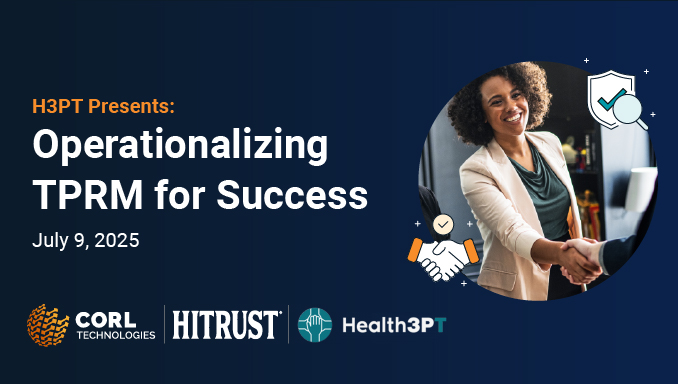
BlogTPRM
Top 10 Healthcare Supplier Risk Management Challenges Facing Providers in 2025
3 Minute Read
Read Top 10 Healthcare Supplier Risk Management Challenges Facing Providers in 2025TPRM
By CORL Technologies | August 4, 2022
Cloud Security Alliance (CSA) recently released new guidance on managing third-party cyber security risk in healthcare that offers some practical and useful tips for defenders to consider.
The report comes on the heels of a new industry report from IBM that cites healthcare as the highest sector for breach costs. The IBM report also notes that 45% of breaches were cloud-based and almost one fifth of breaches occurred because of a compromise at a third-party business partner. [1]
The CSA report is organized around the NIST Cyber Security Framework (NIST CsF) by using the 5 top-level CSF functions (Identify, Protect, Detect, Respond, Recover) to make its recommendations.
CSA is a trusted source of cloud security thought leadership. CORL, and our sister company Meditology Services, are pleased to see them expanding their research into the third-party space.
As in most sectors, healthcare organizations rely more and more on third parties for critical services. Most of these third parties either store or process PHI on behalf of the healthcare organizations or connect to the healthcare organization’s network.
Attackers are well aware of this trend. This reliance on third parties expands the attack surface for healthcare organizations. Attackers are shifting their focus to these third parties to directly compromise healthcare organizations data or as a vector for gaining access to healthcare organizations rather than trying to compromise their systems directly.
CSA cites 3 main reasons that the healthcare industry is struggling to wrap their arms around this growing dynamic:
The bottom line, as stated by CSA, is that “Third parties have been responsible for almost half of all data breaches.”
CSA’s recommended approach to this CSF function is to implement processes to identify new third parties and changes to existing ones. While it does not go into detail on how to assemble this inventory, the most common approach is to work with procurement to identify what vendors are currently being paid and to create vendor capture steps during new contract negotiations. If you need assistance identifying your vendors, consider partnering with a service to take some of the heavy lift off of your resources.
Once the healthcare organizations vendors are identified, the report discusses the importance of establishing an Inherent Risk rating system for your vendors. This Inherent Risk system will help healthcare organizations determine appropriate levels of oversight and set relevant expectations for continuous monitoring and re-assessment for each vendor.
The paper lists some examples considerations for Inherent Risk scoring that include determining if the vendor has access to PHI, data stored in cloud, uses fourth parties, and if the vendor is financially sound, but it stops short of providing the reader an implementable model or calculation for inherent risk. CORL has an inherent risk and vendor prioritization and tiering model that was developed alongside the nation’s leading healthcare organizations. Contact our team if you need help with inherent risk scoring.
The core of the Protect section of the paper advises the use of third-party risk assessments and risk treatment work against the vendor population. Healthcare organizations should conduct risk assessments against their vendors with frequency and depth defined by inherent risk rating tiers.
Some suggestions the paper provides for vendor risk assessments include security control questionnaires, financial risk of the vendor, and assessing risk of business continuity disruption for the healthcare organization if the vendor has a business continuity disruption. CSA also suggests requesting that your vendors provide trusted certifications like HITRUST and SOC2 or 3rd party conducted assessments against a recognized standard like NIST CSF.
On the vendor risk treatment front, it includes recommendations on the elements that should be included in a healthcare organization’s vendor risk treatment plans, but most notably it includes some outstanding advice on practical steps to implement this vendor risk assessment process.
The Detect section of the paper focuses on the need for a healthcare organization to continuously monitor its vendors. CSA explains continuous monitoring to include obtaining a view of vulnerabilities that vendors expose to the internet, validating annual security questionnaires, and using threat intel service providers to harvest relevant threat data targeted to your vendor population.
CSA focuses on the need to create an Incident Response playbook to contain the impact of a potential event. While most organizations have an IR playbook these days, many are still lacking specific sections that cover the nuances of an IR effort that spawns from a third party.
CSA lists some outstanding tips that should be included in that third-party IR playbook:
CSA champions the term “cyber resilience” in the Recover section, which is becoming a well-established term in the industry. The vendor’s job in recovery is to assess how it can return to normal operations quickly. That includes restoring systems, the services that vendor provides to the healthcare organization, and planning how to better protect themselves against future incidents.
The healthcare organization must focus on continuing patient care. To do this, CSA recommends the organization have a team identified to manage the recovery, but CSA really seems to focus more on having a Business Continuity approach. “Once an event has been identified, the team should actively engage vendors to identify alternative sourcing for the service provided by the affected vendor. These sources should be engaged to provide essential services until full service can be restored.”
In addition to the 5 CSF functions covered in this paper, CSA adds some good information to consider when your third parties are using cloud resources. This is a welcome addition given the position CSA holds as a trusted thought leader in the cloud security and cloud controls space.
CSA offers up 6 main risk areas that healthcare organizations should prepare for in cloud computing:
CSA also mentions 5 security measures that healthcare organizations should require of their cloud providers:
Finally, CSA closes this paper with a nod to the importance of healthcare organizations embracing automation to manage their third-party risk. It lists several benefits of automation in third party risk management program, including efficiency and speed, but it does not give specific ideas or examples of how organizations can do it.
That’s where CORL can help!
This research from CSA provides outstanding directional guidance for healthcare organizations to effectively manager third party risk programs, but it stops short of getting into specific detail in many areas. That real-world implementation is where many organizations struggle.
CORL is a service-centered solution for vendor risk management, compliance, and governance that is 100% focused on the unique needs of the healthcare space. Through our managed assessment workflow, our proactive approach to vendor validation and data reuse, and our novel models for accessing and utilizing vendor risk data, we empower healthcare stakeholders to transform TPRM into the powerful enabler it should be.
Many of the key points stated in the paper are reflected in our offering:
CORL agrees with CSAs assessment of the growing third-party risk landscape. Engaging in transformative movements like virtual care, personalized medicine, and predictive analytics leaves providers and payors with a greater variety of vendors than ever before. These vendors, who handle an unprecedented amount of PHI, have the potential to transform healthcare – but they also have the potential to threaten the very bedrock of patient trust. The threat landscape has followed suit with a renewed commitment to compromising vendors through an increasingly sophisticated arsenal of tactics.
Do not face this challenge alone! Contact our team here at CORL to learn more about our service-centered solution that gets results and solves for third party risk at every level of your organization.
 CORL Technologies
CORL Technologies
CORL transforms TPRM chaos into clarity
CORL is a leading provider of vendor risk management solutions for the healthcare industry. CORL gets results by scaling organizational and vendor risk programs through our healthcare vendor risk clearinghouse solution, dashboard reporting that business owners can understand, and proven workflows that drive measurable risk reduction. CORL accelerates the speed of vendor risk assessments and holds vendors accountable for remediating risk exposures.
Related Posts

BlogTPRM
By CORL Technologies | August 14, 2025
3 Minute Read
Read Top 10 Healthcare Supplier Risk Management Challenges Facing Providers in 2025BlogCompliance
By CORL Technologies | June 24, 2025
5 Minute Read
Read Unlocking Vendor Assurance: A Deep Dive into CORL Technologies’ Assessment Suite
BlogTPRM
By CORL Technologies | May 19, 2025
2 Minute Read
Read More Than a Checkbox: Why Right-Sizing Vendor Risk Remediation Is the Key to Smarter TPRM
Webinars
WEBINAR H3PT Presents: Operationalizing TPRM for Success Join us for a focused, real-world conversation with healthcare security and risk leaders tackling today’s most pressing TPRM challenges. This session will bring together a small panel of experts for an insightful discussion on how to strengthen third-party risk programs in an evolving threat landscape. This won’t be […]